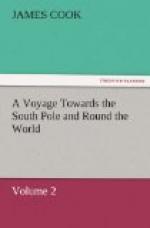I cannot say the women are beauties, but I think them handsome enough for the men, and too handsome for the use that is made of them. Both sexes are of a very dark colour, but not black; nor have they the least characteristic of the negro about them. They make themselves blacker than they really are, by painting their faces with a pigment of the colour of black-lead. They also use another sort which is red, and a third sort brown, or a colour between red and black. All these, but especially the first, they lay on with a liberal hand, not only on the face, but on the neck, shoulders, and breast. The men wear nothing but a belt, and the wrapping leaf as at Mallicollo. The women have a kind of petticoat made of the filaments of the plantain-tree, flags, or some such thing, which reaches below the knee. Both sexes wear ornaments, such as bracelets, ear-rings, necklaces, and amulets. The bracelets are chiefly worn by the men; some made of sea-shells, and others of those of the cocoa-nut. The men also wear amulets; and those of most value being made of a greenish stone, the green stone of New Zealand is valued by them for this purpose. Necklaces are chiefly used by the women, and made mostly of shells. Ear-rings are common to both sexes, and those valued most are made of tortoise-shell. Some of our people having got some at the Friendly Islands, brought it to a good market here, where it was of more value than any thing we had besides; from which I conclude that these people catch but few turtle, though I saw one in the harbour, just as we were getting under sail. I observed that, towards the latter end of our stay, they began to ask for hatchets, and large nails, so that it is likely they had found that iron is more serviceable than stone, bone, or shells, of which all their tools I have seen are made. Their stone hatchets, at least all those I saw, are not in the shape of adzes, as at the other islands, but more like an axe. In the helve, which is pretty thick, is made a hole into which the stone is fixed.
These people, besides the cultivation of ground, have few other arts worth mentioning. They know how to make a coarse kind of matting, and a coarse cloth of the bark of a tree, which is used chiefly for belts. The workmanship of their canoes, I have before observed, is very rude; and their arms, with which they take the most pains in point of neatness, come far short of some others we have seen. Their weapons are clubs, spears or darts, bows and arrows, and stones. The clubs are of three or four kinds, and from three to five feet long. They seem to place most dependence on the darts, which are pointed with three bearded edges. In throwing them they make use of a becket, that is, a piece of stiff plaited cord about six inches long, with an eye in one end and a knot at the other. The eye is fixed on the fore-finger of the right hand, and the other end is hitched round the dart, where it is nearly on an equipoise. They hold the dart




